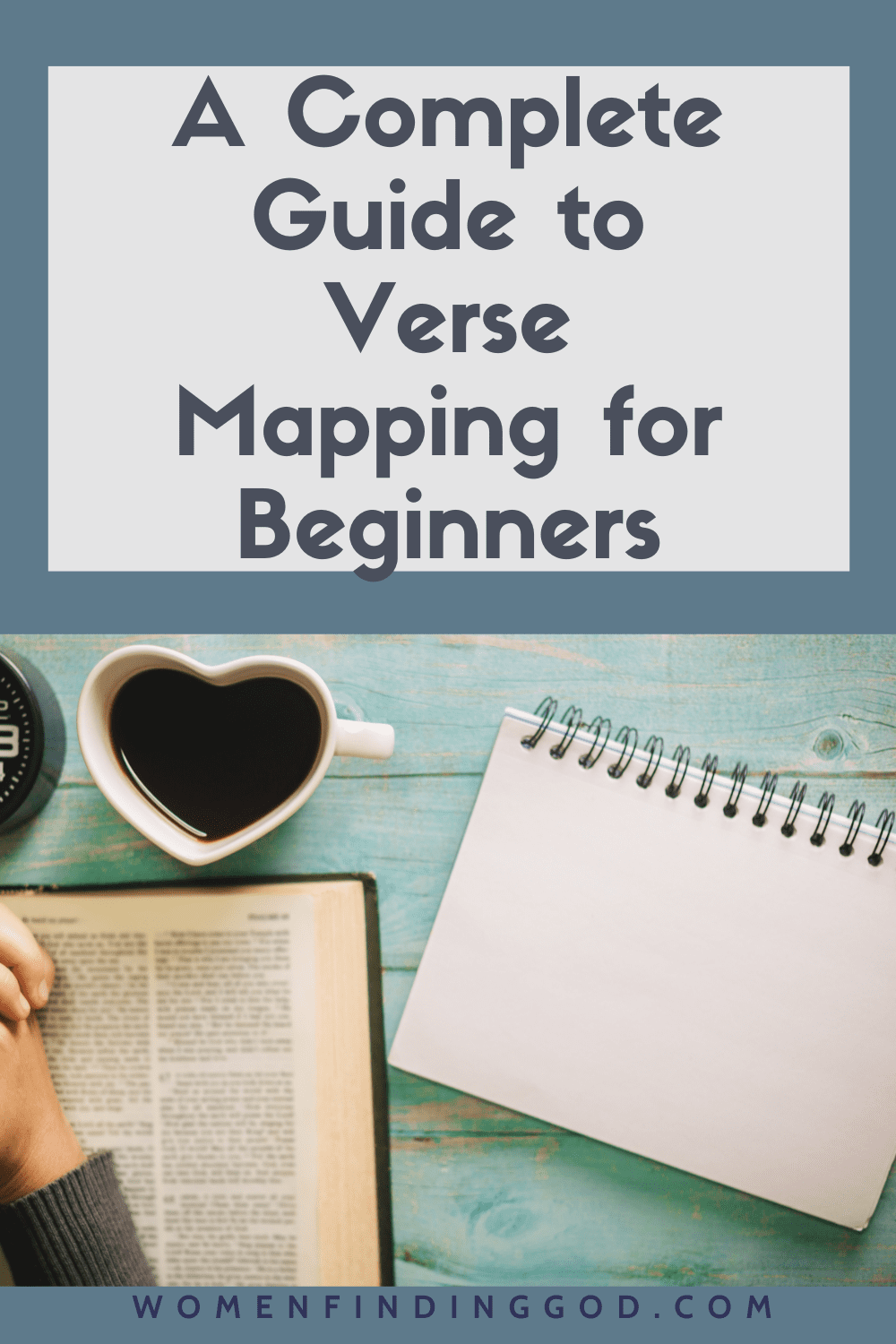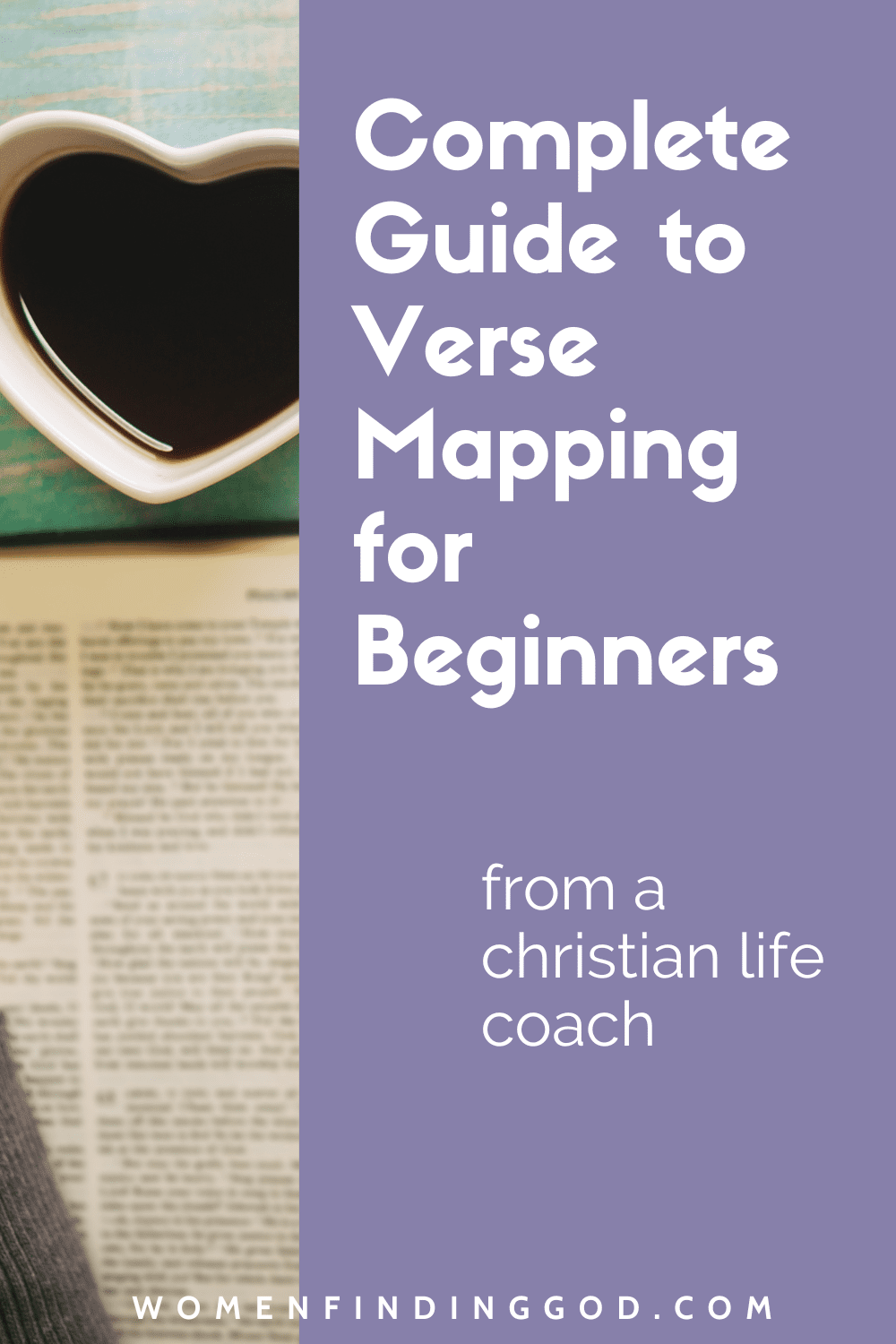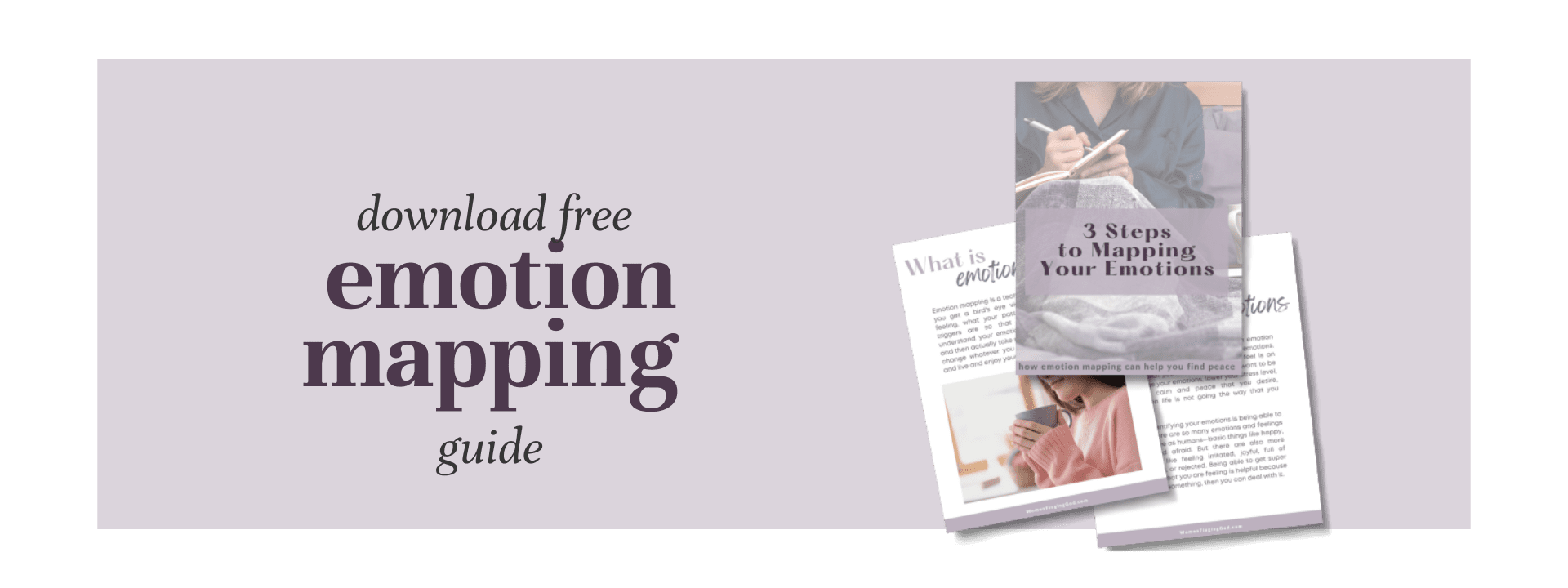6 Step Plan: Study The Bible One Verse At A Time
Have a hard time fitting Bible study into your daily quiet time with God? Verse mapping is an easy way to dig into God’s word one verse at a time. These step-by-step instructions will help end your Bible study struggles for good!
I was really looking forward to my time with God that morning.
I was feeling a little worn and weary and just needed a word of encouragement to lift my spirit. I grabbed my quiet time basket and headed to my favorite spot.
There was just one problem that morning, I wasn’t sure what to read or study. I didn’t know where to look for the comfort I desperately needed at that moment. So I prayed. I asked God to speak to me through His word.
I grabbed my Bible and started flipping through the book of Proverbs. My go-to place when I need some wisdom or guidance. I scanned the pages until my eyes landed on Chapter 3, verses 5 and 6. “Trust in the Lord with all your heart . . .”
Familiar words. I’d heard them many times before. I was sure that I had read them a few times as well. There was just one problem. I wasn’t really sure what they meant. There had been times when I truly believed that I was trusting in God with all my heart but I always seemed to make a mess of things.
Can you relate to that feeling?
Want to follow God’s commands and obey His word but have no idea where to get started? Have you ever read your Bible but couldn’t figure out how to walk out what the scripture said?
It’s a common struggle to have. And God promises in His word that will give understanding and wisdom to anyone that asks for it.
That day I asked God to help me to understand that Proverb so that I could walk in obedience to His word. And He did. God used verse mapping to help me finally understand this verse and so many others!

Verse mapping is simply a method of verse-by-verse Bible study. You will take one verse and study every single word so that you have a better understanding of scripture. You’ll also study the historical context of each passage of scripture, read different translations and use cross-references to see how that specific verse fits in with the rest of scripture.
Why is Verse Mapping Great for Beginners
Verse mapping is perfect for beginners because it’s easy to do and it’s extremely flexible.
There’s a clear structure and format to verse mapping which makes it easy to follow. You don’t have to spend time trying to decide how to get started or what to look for. You’ll follow the same steps for every verse you want to study and it works for 1 verse or an entire passage of scripture.
This method can take as little as 15 minutes to as much as an hour. It all depends on how much time you have, how many verses you want to study, and how deep you want to go. There’s no time commitment or restraint.
This is also a Bible study method that is easy to start and stop. This is so important because often we get tripped up because life happens or seasons change when we just can’t continue the pace we were doing before. That’s not an issue here. You can work for 15 minutes, take a break and then pick back up where you left off. Easy peasy, no falling behind, and no pressure.
Feeling overwhelmed by challenges, uncertain about your faith, and struggling to manage your emotions alone? Want to climb out of your pit of despair? It’s exhausting when every hurdle feels insurmountable and your emotions threaten to drown you. But what if you didn’t have to navigate this journey alone? Take the first step towards peace. Book your Mindset Coaching package today!

General Guidelines for Verse Mapping
Keep everything grounded in scripture
There is a temptation to take the bible and make it fit into today’s world. Please don’t fall into that pit when you are verse mapping. Keep everything – context, meanings, application – grounded in scripture. You want to learn how you can walk out the bible in your everyday life.
Make it work for you
There is a structure or format to verse mapping but that doesn’t mean there’s no room for creativity or adding your own flair to the process. You get to decide how you mark up a verse, where you keep your notes and how to organize your supplies.
If you like to draw then include that into your study time and your notes. Prefer to write things out in lists and bullet points — go for it. It needs to work for you. If it doesn’t then you won’t stick with it or learn anything.
One suggestion: once you find what works stick with it. If you make constant changes it will hinder your learning and growth.
Be yourself
Your journal is just for you and God don’t worry about being formal. No one is checking your work or looking over your shoulder to see if you’re doing it correctly. It’s okay to be messy, make mistakes, whatever.

Verse Mapping Supplies
Before we get started with the step-by-step instructions you’ll need to gather your supplies:
Bible
You can use any Bible you have access to. You will want to have access to a few different translations. There are parallel bibles you could purchase or just look online at places like Bible Gateway and Bible Study Tools.
Notebook or journal
You will be taking lots of notes so you’ll need something to write on. Regular notebook or computer paper works just fine. I would recommend a notebook of some kind to keep track of your notes. Index cards are also a good option if you are just doing one short verse.
My personal preference is to use a journal for all my bible study notes. Keeps everything all in one place and it’s easy to carry with me when I’m not studying at home.
Writing tools
You will want to have a few pens/pencils/highlighters available to you. These will help you stay organized as you begin to map out your verse. Don’t get focused on finding the perfect pen to use for your study time. Start with what you have and try new things when you are able to.
Reference books
At a minimum, you’ll need access to a dictionary. I also like to have a Bible dictionary and concordance close by when I study. Also maps and timelines are also helpful when you are studying the background and historical context. You can access these online as well. My two favorite sources are Bible Study Tools and Blue Letter Bible.
Choosing a Verse to Study
Once you have all your supplies ready, the next step is to choose a verse to study. Don’t spend a lot of time stressing over this decision. Here are some ways to choose your verse:
- Monthly Reading Plan: A great way to get more out of a reading plan is to map out each verse daily
- Scriptures from Sunday’s sermon: Jot down the scripture references your pastor teaches on Sunday mornings and then spend the week meditating and studying these verses on your own
- Verses that you don’t understand: When you come across a verse that makes you scratch your head, mapping it out will help you gain a clearer understanding.
- Passages of scripture: You can dig deep into a section of scripture by taking the time to map out each verse. This will help you understand that entire passage more than if you just read it in one sitting and moved on.
Now we are ready to get to work!

Verse Mapping for Beginners
Before we jump into the nitty gritty of verse mapping I want to take a moment to remind/bring to your attention the importance of prayer when it comes to your bible study.
We should always be prayerful when trying new things but especially when we endeavor on new spiritual disciplines. There’s an enemy that wants to do everything he can to discourage and distract you from spending time in the Word. So take some time to go on the offensive and pray over your efforts and spiritual growth!
Step 1: Read/Write the verse
Once you have your verse picked out, take some time to read the verse. If time allows it’s always a good idea to read the entire passage of scripture around your verse. This will help you to have context for all the notes that you will take as you begin to look up words.
This doesn’t have to take a lot of time. Read what you can. If it’s just a few verses before and after that is fantastic. If you have more time and can read the entire chapter or even the whole book of the Bible even better. You just want to have a picture in your mind about what’s going on in scripture as you begin to study.
Then write the verse down. Write out the entire verse that you want to study on a piece of paper, in your journal, or on a notecard.
Step 2: Context
Anytime you are studying scripture you need to make sure that you understand what’s going on. Who’s the author, who’s the audience, and where in biblical history are you? These are questions you need to take the time to answer.
You may have this information in the notes of your bible you may not. Use the reference tools that I mentioned above. Commentaries can also be helpful when you need to know what’s going on.
The Bible Project is one of my favorite places to go when I want to understand things like themes, audience, and history. They have a video that outlines and summarizes every single book of the bible for you.
Step 3: Choose 2-3 other translations
Once you have an understanding of the context for your verse or passage it’s time to look at some other translations.
Remember the bible was not originally written in English – or whatever language you speak and read. Men and women translate from original Hebrew, Aramaic, or Greek. That means that sometimes it’s hard to get the exact meaning across. This is often why you’ll see different words used.
Reading multiple translations will help you get a clearer picture of what your verse is saying. You can add the different translations to your page and notes.
Step 4: Choose and research keywords
Using a highlighter, colored pencil, or your favorite pen mark the words or phrases that jump out at you. The things that you want to learn more about. There’s no right or wrong here, different things will jump out at you at different times.
Here’s an example, if I was going to study Proverbs 3:5 I would mark the following words to study (The words in bold are the ones that I will look up in my resource materials.):
Trust in the Lord with all your heart, and do not lean on your own understanding.
Once you’ve marked your words it’s time to pull out your dictionary. Look up each word and write down what they mean. Be sure to take note if the word is a verb, adjective or noun because that can sometimes affect the meaning.
I always like to start with a regular English dictionary when I get to this study. But if I have more time I also like to look up the words in my Bible dictionary. Sometimes, words don’t mean what we think they do when we get back to the original Greek or Hebrew. If you don’t have time for that no worries.
By the end of this step, you should have a nice list of definitions ready to use.
Now that you have looked up each word, take a few minutes to rewrite the verse using the definitions of the words. Our previous example might look something like this:
Believe in the reliability, truth, ability, or strength of the Lord with all the central or innermost part of your being, and do not rely for support or inspiration on your own ability to understand something.
Step 5: Cross-references
Now it’s time to pull out your concordance and look up other verses that use the words that you marked. From our example: trust, heart, lean, and understanding. Start making a list of each reference that you find.
Next, start reading through your list to help you see how each keyword it was used and what it meant in different parts of scripture. This will add to your understanding.
Step 6: Application & Reflection
No Bible study is complete until we take some time to apply it to our lives. Often studying scripture will reveal something that we need to change about our walk with God.
I like to ask myself the following questions:
- How can I apply this verse to my life/situation?
- What did I learn about God from this verse?
- Are there any commands/warnings/promises I should make note of?
Take some time to think through each of these questions and make note of anything else that comes to mind. Finally, I like to end with a few minutes of prayer.

Taking Verse Mapping Deeper
If you ever want to take what you’re learning in your verse map a little deeper, I have some other suggestions for you:
Do a word study
You could take your list of cross-references and spend time doing a word study. A word study is a deep-dive into one word. You’d track it throughout the entirety of scripture. Reading and studying every time that word is used in the Bible. You could also spend time mapping out each cross-reference.
Character/Event study
If you come across a particular person or event during your background research that’s a great jumping-off point for further study. Set your verse mapping aside for a short time to dig into scripture about a person (Abraham, Esther, Paul, Jesus) or learn about a specific event (Passover, Exile, etc).
Scripture Memorization
Now that you have a better understanding of the verse you mapped take it one step further by memorizing it. Rote memorization of scripture tends to miss the mark if you don’t know what you’re saying.
Don’t forget those cross-references too! If there’s a particular verse or verses that really touched you in your studies why not hide them in your heart.
Maps & Timelines
You may have used a map or a timeline as part of your studies. Creating your own maps and timelines can be a great addition to your time in the word. You don’t have to come up with anything from scratch either. Simply copying something you have found in a book or online resource works great.
When you take the time to draw and write out this information you’ll remember it more because you actually did something with it. And you can continue to add to a timeline as you study more of God’s word.
Other Helpful Resources:
- How to Seek God in Your Christian Walk
- Are Affirmations and Meditation Biblical?
- How to Reconnect with God After a Long Break

Do you emotions feel too BIG to handle? Learn how emotion mapping can help you calm down, rewire your brain, and learn to cope better so you can have peace and joy again!








